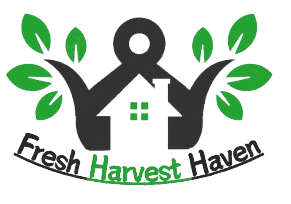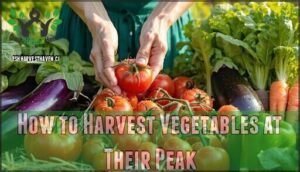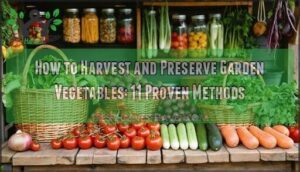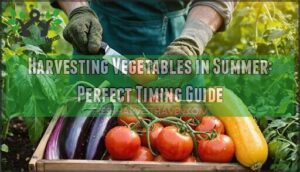This site is supported by our readers. We may earn a commission, at no cost to you, if you purchase through links.
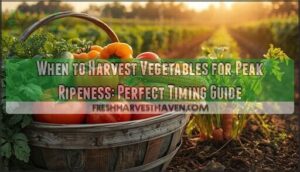 When you’re figuring out when to harvest vegetables for peak ripeness, look for each veggie’s unique cues—deep reds on tomatoes, bright hues on peppers, or brown silks on corn all point to perfect timing.
When you’re figuring out when to harvest vegetables for peak ripeness, look for each veggie’s unique cues—deep reds on tomatoes, bright hues on peppers, or brown silks on corn all point to perfect timing.
Watch the weather, since a surprise rain can drown out flavor, while a heatwave or sudden frost can rush things along.
Check the field in the morning for cooler temps and less stress on the crops. If a cucumber feels smooth and firm or carrots show orange shoulders at the soil line, it’s showtime.
Master these small details, and you’ll taste the reward—more secrets coming next, with peak ripeness and unique cues being key to a successful harvest, and understanding the importance of perfect timing.
Table Of Contents
- Key Takeaways
- Harvest Timing Factors
- When to Harvest Vegetables
- Harvest Readiness Signs
- Harvesting Best Practices
- Post Harvest Storage Tips
- Frequently Asked Questions (FAQs)
- When is the best time to harvest vegetables?
- When do vegetables ripen & harvest?
- How do you know if a vegetable is ready for harvest?
- What should I do if I find vegetables past harvest time?
- When should you pick vegetables?
- When should you pick your produce?
- What vegetables mature in 30 days?
- Does it matter what time of day you harvest vegetables?
- Is September too late to plant vegetables?
- When do vegetables ripen?
- Conclusion
Key Takeaways
- Watch each veggie’s color, firmness, and aroma—these give you the best signals for peak ripeness.
- Harvest in the early morning once dew dries to lock in moisture and flavor.
- Check your garden every few days; frequent picking keeps plants productive and avoids overripe losses.
- Handle produce gently and use sharp tools to prevent bruising and extend shelf life.
Harvest Timing Factors
Knowing when to harvest your vegetables requires understanding several key timing factors that directly affect flavor, nutrition, and shelf life.
Weather conditions, crop maturity stages, day length changes, and temperature fluctuations all work together to signal the perfect harvest window for each type of vegetable in your garden, considering complete concepts.
Weather Conditions
Weather can make or break your harvest season.
Cloudbursts, heatwaves, and sudden frosts all play a part in perfect harvest timing. To hit peak ripeness for your vegetables, watch out for these three key factors:
- Sudden Rainfall Patterns dilute flavor and hasten spoilage.
- Temperature dips signal risk of Frost Timing.
- High Wind Effects cause water loss and bruising.
The key factors to watch out for are related to weather conditions that can impact the quality and timing of your harvest.
Crop Maturity
Understanding crop maturity requires monitoring specific ripeness signs that reveal peak harvest timing.
Each vegetable reaches maturity stages at different rates, making crop monitoring essential for superior fruit quality.
You’ll notice harvest cues like color changes in tomatoes shifting from green to pink, or carrots showing orange shoulders through soil.
Vegetable ripeness indicators include firm texture in cucumbers and glossy skin on eggplants before dullness appears.
Accurate maturity assessment involves using maturity determination methods to guarantee the best results, ensuring superior fruit quality through proper monitoring and evaluation.
Day Length
Daylight hours substantially influence your vegetable harvest schedule.
Most vegetables respond to photoperiod changes, with shorter days triggering final maturation in crops like onions and garlic.
Daily cycles of light exposure affect when ripe vegetables reach peak quality.
Morning sunrise timing determines ideal harvest windows, as many vegetables concentrate sugars overnight.
Understanding these natural rhythms helps you plan the best time to harvest for maximum vegetable maturity and take advantage of the optimal harvest schedule.
Temperature Effects
Temperature dramatically affects vegetable harvest time and peak freshness.
You’ll need to monitor both air and soil temperature for ideal vegetable ripeness. Heat stress and cold damage can destroy your harvest schedule if you’re not careful.
Key temperature considerations:
- Heat Stress – Temperatures above 85°F slow vegetable maturity and reduce quality
- Frost Timing – Harvest before first frost to prevent cold damage and thermal shock
- Soil Temperature – Must reach 60°F minimum for proper root vegetable development
- Thermal Shock – Sudden temperature changes halt ripening processes completely
When to Harvest Vegetables
Timing your vegetable harvest correctly can make the difference between bland produce and garden gold. You’ll want to master the art of crop monitoring through regular garden walks, checking your plants every few days as they approach maturity.
Peak freshness depends on understanding each vegetable’s unique timeline – some crops like lettuce prefer cool mornings, while tomatoes need warm afternoons to develop full flavor. Your harvest tools should stay sharp and clean to prevent plant damage.
Garden planning helps you stagger plantings for continuous harvests rather than overwhelming bounties. Soil quality affects vegetable ripening speed, so well-fed plants often mature more predictably. Understanding harvest timing importance is vital for maximizing flavor and nutrient density.
| Vegetable | Best Harvest Time |
|---|---|
| Tomatoes | Morning, after dew dries |
| Lettuce | Early morning, cool temps |
| Peppers | Afternoon, warm weather |
| Carrots | Anytime, soil workable |
| Zucchini | Every 2-3 days when young |
When to pick vegetables requires balancing plant needs with your schedule – frequent harvesting encourages continued production in most crops, leading to a successful harvest and ensuring peak freshness is maintained throughout the growing season.
Harvest Readiness Signs
You’ll know your vegetables are ready to harvest by watching for specific visual and physical cues that signal peak ripeness.
These natural indicators help you time your harvest perfectly to capture maximum flavor, nutrition, and quality in your homegrown produce.
Color Changes
Ripening signs become your harvest compass as vegetables transform before your eyes.
Color shift offers the most reliable visual cues for timing your harvest perfectly.
Different vegetables display distinct hue indicators that signal peak ripeness and optimal flavor development.
- Tomatoes: Deep red or orange coloration indicates 80-90% surface color change from green, signaling maximum lycopene content
- Peppers: Vibrant red, orange, or yellow hues develop when 70% of retail-quality color emerges, enhancing flavor profiles substantially
- Cucumbers: Deep green with consistent gloss signals readiness; yellowing indicates overmaturity and declining quality
- Eggplants: Uniform glossy purple or black skin shows peak ripeness; dull surfaces suggest the harvest window has passed
- Carrots: Rich orange tops peeking through soil indicate beta-carotene concentration has reached its maximum nutritional value
These tint signals guide your harvesting decisions with scientific precision, ensuring you capture vegetables at their nutritional and flavor peaks.
Aroma and Texture
Your nose knows best when vegetables reach peak ripeness.
Let your senses lead the way—ripe vegetables always announce themselves with irresistible fragrance and freshness
Trust your senses—they’re nature’s perfect ripeness detector.
Fragrant signs emerge as tomatoes develop their signature sweet aroma, while melons release their characteristic musky scent.
Texture tests reveal readiness through gentle pressure – ripe avocados yield slightly, cucumbers feel firm yet crisp.
These aromatic changes and sensory evaluation methods provide reliable ripeness checks for your harvesting guide, making vegetable gardening tips more effective than visual cues alone, using your nose.
Size and Shape
Perfect vegetable sizing and fruit shapes signal peak harvest time in your garden.
Root vegetables like carrots show orange tops peeking through soil, while beets reach ideal 2-3 inch diameter.
Leafy greens maintain compact shapes before bolting.
Zucchini harvests best at 6 inches long, and these harvest metrics guide your harvesting decisions for superior crop maturity and flavor.
Silks Turning Brown
Brown silks signal corn harvest readiness. Watch for silks turning brown and dry about 19-23 days after they first appear.
These brown silks indicate successful seed formation and kernel maturity. Pull a few silks – they should come out easily when corn reaches peak ripeness.
Green or wet silks mean your crop needs more time for proper dry down before husk removal. Understanding the corn ripening stages is vital for determining the ideal harvest time and ensuring proper dry down.
Yield to Touch
Through gentle pressure and Tactile Inspection, you’ll master the art of determining vegetable ripeness.
A Firmness Check reveals when crops reach peak harvest time. This Ripeness Test prevents picking underripe or overripe vegetables, maximizing crop yield and flavor quality.
- Gentle Squeeze test: Apply light pressure to tomatoes, peaches, and stone fruits – they should yield slightly without being mushy
- Skin Texture assessment: Run fingers along cucumber and zucchini surfaces – smooth, firm skin indicates ideal harvesting vegetables timing
- Surface give evaluation: Press root vegetables like potatoes and onions – mature crops resist pressure while maintaining slight flexibility
Harvesting Best Practices
You’ll get the best results by harvesting vegetables in the morning, using sharp tools, and handling each crop gently to avoid bruising.
Frequent picking keeps plants productive and helps maintain peak ripeness and quality.
Harvesting in Morning
When harvesting vegetables, timing matters most during early morning hours.
Morning Harvest Tips include picking after sunrise but before temperatures rise.
Early Picking captures peak moisture content and firmness.
Dew Management requires waiting until moisture evaporates to prevent disease spread.
Sunrise Timing guarantees vegetables retain maximum nutritional value and crispness for storage.
Effective farming utilizes proper Morning Harvest Tools to streamline the process, ensuring the use of proper tools.
Handling Produce Gently
When harvest time arrives, your vegetable garden demands the same care you’d give precious china.
Gentle handling during delicate harvesting protects your crops from bruising and damage that reduces storage life.
Essential produce care techniques:
- Support heavy fruits like melons and squash with both hands
- Avoid dropping vegetables into containers from any height
- Handle leafy greens by their stems, not fragile leaves
- Place produce in shallow baskets to prevent crushing bottom layers
- Never squeeze soft fruits during fruit protection checks
Crop handling requires patience—rushing leads to costly mistakes that affect quality.
Using Sharp Tools
Sharp blades make clean cuts that heal faster and reduce plant stress.
Clean your garden shears between plants to prevent disease spread. Dull tools crush stems, creating entry points for bacteria and fungi.
Sharp cutting techniques protect delicate vegetables like tomatoes and peppers. Proper tool maintenance guarantees efficient harvesting and healthier plants for continued production.
Regular use of high-quality garden shears tools is essential for superior results.
Harvesting Frequently
Your garden becomes more productive when you stick to frequent picking schedules.
Regular harvest every few days triggers plants to produce more flowers and fruits, boosting yields by up to thirty percent.
Daily vegetable harvest prevents overripe produce from attracting pests and diseases.
Smart garden planning with consistent harvest time maximizes your picking vegetables success throughout the growing season, which can lead to thirty percent more yields and ensure frequent picking schedules are effective.
Post Harvest Storage Tips
Once you’ve harvested your vegetables at peak ripeness, proper storage becomes essential for maintaining their quality and extending their shelf life.
Handle your garden’s bounty with care—smart storage keeps your harvest fresh, flavorful, and ready for every meal
The right storage method depends on each vegetable’s specific needs, whether that’s cool and dry conditions, cold and moist environments, or preservation techniques like pickling and freezing.
Cool and Dry Storage
Several vegetables thrive when you store them in cool, dry conditions after your vegetable harvest. This crop preservation method extends shelf life substantially when you maintain proper humidity control and use appropriate storage containers.
- Set up your cool room between 50-60°F with humidity under 65% for ideal food preservation conditions.
- Choose proper storage containers like mesh baskets or shallow crates that allow airflow around your stored vegetables.
- Cure vegetables first by letting onions, garlic, and winter squash dry for 1-2 weeks before storage.
- Monitor regularly by checking weekly for sprouting, softness, or decay that can spread to healthy produce.
- Maintain proper ventilation to prevent moisture buildup and mold development in your storage area. Understanding essential storage conditions is vital for maximizing the shelf life of your harvested vegetables.
Cold and Moist Storage
Most vegetables thrive in cold storage with proper humidity control.
Set your refrigerator between 32-40°F and maintain moisture levels around 85-95% for leafy greens, carrots, and broccoli.
Use perforated storage containers or plastic bags with small holes for refrigeration tips.
This agricultural practice extends harvest storage substantially, keeping your vegetable harvest fresh for weeks after crop management decisions at harvest time.
Pickling and Canning
Preserving your garden harvest through pickling methods and canning safety extends your vegetable garden’s bounty year-round.
Food preservation requires proper jar sterilization and maintaining correct acid levels to prevent spoilage. You’ll want to follow tested recipes that guarantee safe pH levels, especially when canning low-acid vegetables.
Pickling transforms cucumbers, peppers, and beans into tangy treats that capture harvest time flavors perfectly. To guarantee the longevity of your preserved vegetables, it’s vital to use proper canning jar equipment and techniques, ensuring canning safety and proper jar sterilization.
Freezing and Long-Term Storage
Most vegetables freeze best when harvested at peak ripeness and processed within two hours.
Flash freezing at 0°F preserves 90% of original nutrition, while proper storage containers prevent freezer burn.
Blanch vegetables for 1-3 minutes before freezing to maintain color and texture.
Quality frozen vegetables last 8-12 months in cold storage conditions.
Frequently Asked Questions (FAQs)
When is the best time to harvest vegetables?
Pick most vegetables when they’re firm, brightly colored, and just the right size for their variety.
Gently squeeze; ripe tomatoes should give a little, while cucumbers stay crisp.
Trust your eyes, hands, and a bit of common sense to guide you in choosing the best vegetables, and remember to gently squeeze them to check for ripeness.
When do vegetables ripen & harvest?
Vegetables ripen on their own clock—carrots reveal orange tops, tomatoes soften at the “breaker stage,” and eggplants shine.
Watch for color changes, firmness, and that perfect size.
Harvest early in the morning for maximum crispness and flavor.
How do you know if a vegetable is ready for harvest?
You’ll know a vegetable’s ready when its color deepens, size matches the variety, and it feels firm but not hard.
Slightly soft tomatoes, snappy beans, and shiny eggplants are all good signs you’re in for a tasty haul.
What should I do if I find vegetables past harvest time?
If you stumble across veggies that missed their prime, compost them or use as animal feed.
Overripe produce can attract pests and spread disease, so clear beds quickly to keep your garden healthy and productive.
When should you pick vegetables?
Firm, vibrant color, and a slight give when pressed signal vegetables are ready to pick.
Early morning usually preserves the best flavor.
Keep an eye out for size, shine, and texture—each crop has its own sweet spot.
When should you pick your produce?
Just when you think it might be too soon, check for true color—shiny skin, a little give, or visible tops peeking out.
Snap or twist gently; if it comes away cleanly, you’ve timed it right.
What vegetables mature in 30 days?
Radishes, baby carrots, arugula, spinach, and lettuce wrap up in about 30 days.
You’ll want to check their leaves or roots for size and color.
These quick growers are perfect if you’re impatient for that first harvest.
Does it matter what time of day you harvest vegetables?
Like picking fruit at dawn’s golden hour, harvesting vegetables early in the morning locks in moisture, keeping them crisp and flavorful.
Heat later in the day can lead to wilting, lower quality, and quicker spoilage, which is a key consideration for maintaining crisp vegetables.
Is September too late to plant vegetables?
September isn’t too late if you choose fast-growing, cool-season crops.
Plant leafy greens, radishes, spinach, or turnips.
These thrive in chilly soil, so you’ll still reap a harvest before winter’s chill sets in.
When do vegetables ripen?
Four and a half billion hours—now that’s dedication to tracking details!
You’ll notice vegetables ripen in stages: color deepens, firmness gives, and flavors sweeten.
Check each crop; carrots show orange tops, tomatoes soften, zucchini reach six inches.
Conclusion
Picture stepping into your garden at dawn, searching for the early clues that reveal when to harvest vegetables for peak ripeness.
By noticing small details—like the color shift on peppers or a carrot’s orange crown—you’ll master the art of perfect timing.
Consistent observation, the right tools, and gentle handling all support your harvest success.
When you apply these principles, you’ll maximize flavor, guarantee freshness, and confidently enjoy crops picked at their peak ripeness.
- https://fieldreport.caes.uga.edu/publications/C935/when-to-harvest-vegetables/
- https://agriculture.institute/post-harvest-mgt-principles/determining-maturity-of-fruits-vegetables/
- https://www.stablemicrosystems.com/measure-ripeness.html
- https://www.reddit.com/r/vegetablegardening/comments/1mg6lou/how_do_you_know_when_corn_is_ripe_and_ready_to_be/
- https://www.azplantlady.com/2010/05/ears-of-silk-in-vegetable-garden-corn-ripening-stages.html
